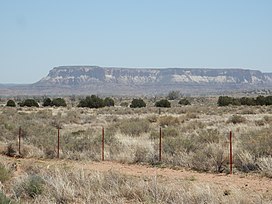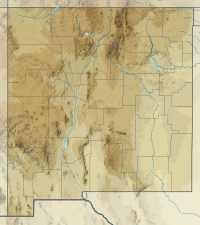geo.wikisort.org - Mountains
Dowa Yalanne (Zuni: "Corn Mountain") is a steep mesa 3.1 miles (5 km) southeast of the present Pueblo of Zuni, on the Zuni Indian Reservation. Plainly visible from the Zuni Pueblo, the mesa is located in McKinley County, New Mexico,[3] and has an elevation of 7,274 feet (2,217 m). The mesa is a sacred place for the Zuni people, who fled to the mesa top to escape the Coronado expedition in 1540, and it is closed to outside visitors.
| Dowa Yalanne | |
|---|---|
 Dowa Yalanne, the "Corn Mountain" of the Zuni people | |
| Highest point | |
| Elevation | 7,274 ft (2,217 m) NGVD 29[1] |
| Coordinates | 35°03′10″N 108°47′32″W[2] |
| Geography | |
 Dowa Yalanne Location in New Mexico | |
| Location | McKinley County, New Mexico, U.S. |
| Topo map | USGS Zuni |
History
Dowa Yalanne was settled before European contact.[4]
In 1540, Zuni people from the village of Hawikuu fled to the Dowa Yalanne mesa top to escape the attackers of the Coronado expedition. The 14 structures used as a refuge from the Spaniards between 1540 and 1680 were called Heshoda Ayahltona ("ancient buildings above").[5]
Before the Pueblo Revolt of 1680, the Zuni lived in six different villages. After the revolt, until 1692, they took refuge in a defensible position atop Dowa Yalanne. About 48 Pueblo structures were built between 1680 and 1692 on the top of the mesa, which covers approximately 320 acres (130 ha). The population of Dowa Yalanne in 1680 is estimated to have been approximately 2500 people, living in buildings of one and two stories, with over 500 rooms.[5]
On November 11, 1692, Don Diego de Vargas climbed to the top of Dowa Yalanne and baptized over 290 people.[6]
After the establishment of peace and the return of the Spanish, the Zuni relocated to their present location, only briefly returning to the mesa top in 1703.[5]
According to T.J. Ferguson,
The village on Dowa Yalanne was pivotal in the development of historic settlement patterns. It is the first village in which the whole Zuni population gathered into a single settlement. Although it is unlikely that the contact period villages were totally abandoned, apparently every Zuni family maintained a residence on top of Dowa Yalanne that could be used for refuge when the Spaniards returned. The mesa top was also a position defensible against the hostile attacks of the Apaches.[7]
Culture
Dowa Yalanne is sacred to the Zuni people. The mesa is a place for shrines and religious activities, and is closed to outside visitors. The rising sun reaches a spot on the southwest of the mesa at winter solstice.[8] Dowa Yalanne is "mythologically associated with the 'House of the Gods and the making of rain, lightning, and thunder,' and from this came its alternate name, 'Thunder Mountain.' "[5]
Other alternate names for the mesa have included To'wa Yäl'länne, Tay-a-ol-o-ne, Taaiyalone Mountain, Tâaiyá'hltona Hlúelawa, and "Peñol de Caquima," a Spanish pronunciation of the old village of Kyaki:ma, located at the base of the mesa.[5] A traditional tale, "The Great Dancing Tarantula", takes place at the foot of Dowa Yalanne.[9]
Dowa Yalanne Elementary school is located near the mesa.[10] A program for Zuni youth, DY-MESA ("Developing Youth: Mentoring Empowerment Self-expression Achievement") is named after the mesa, as "a source of the strength for the Zuni Pueblo."[11]
The aviary of the Zuni Eagle Sanctuary, which cares for injured golden and bald eagles, "was designed so the eagles could view the mesa from their cages."[12]
Geology
The red rock of the mesa is Entrada Sandstone, with white bands.[13] The top layer of rock is Dakota Sandstone. The mesa's white Zuni Sandstone is the source of flat baking stones for "hewe", a paper-thin cornbread prepared for special occasions.[5] Springs around the mesa are a traditional source of water.[14]
References
- "Dowa Yalanne". ListsOfJohn.com. Retrieved 2014-02-15.
- "Dowa Yalanne". Geographic Names Information System. United States Geological Survey. Retrieved 2014-02-15.
- "ZYEP – Zuni Youth Enrichment Project: The Zuni Pueblo". Retrieved 2014-02-04.
- "What Are the Key Events of Zuni History?". WiseGeek. Retrieved 19 February 2014.
- Flint, Richard; Flint, Shirley Cushing. "Dowa Yalanne, or Corn Mountain". New Mexico Office of the State Historian. Retrieved 2014-02-07.
- Wiget, Andrew (1996). "Father Juan Greyrobe: Reconstructing Tradition Histories, and the Reliability and Validity of Uncorroborated Oral Tradition". Ethnohistory, Via Academic Room. 43 (3): 459–482. doi:10.2307/483453. JSTOR 483453.
- Ferguson, T. J. "People of the Colorado Plateau-The Zuni (part 2 of 4)". Land Use History of North America Colorado Plateau. Archived from the original on 2011-11-20. Retrieved 2014-02-04.. From Historic Zuni Architecture and Society: An Archaeological Application of Space Syntax
- The A:shiwi (Zuni) People: A Study in Environment, Adaptation, and Agricultural Practices (PDF). Native People and the Land. Smithsonian National Museum of the American Indian. December 15, 2008. Retrieved April 27, 2013.
- Torgersen, Don Arthur. "The Great Dancing Tarantula: A Zuni Pueblo Tale". Tree of Tales. Retrieved 2014-02-04.
- "Dowa Yalanne Elementary". Zuni Public Schools – Official Website. Archived from the original on 2014-02-21. Retrieved 2014-02-04.
- Leizens, Tish (2012-08-02). "Zuni Pueblo Model Paves Way For Healthy Kids - ICTMN.com". Indian Country Today Media Network. Retrieved 2014-02-04.
- "UF professors collaborate with tribe to design eagle aviary". University of Florida News. 2005-03-03. Archived from the original on 2014-02-22. Retrieved 2014-02-04.
- "Dowa Yalanne Zuni Pueblo Prince And Princess – Painting by Chris Easley". Retrieved 2014-02-04.
- "Zuni Dowa Yalanne" (PDF). Zuni Visitors Guide. 2005. Archived from the original (PDF) on 2014-02-22. Retrieved 2014-02-04.
Further reading
- Ferguson, T.J. "Dowa Yalanne: The Architecture of Zuni Resistance and Social Change during the Pueblo Revolt." In Archaeologies of the Pueblo Revolt: Identity, Meaning, and Renewal in the Pueblo World, edited by Robert W. Preucel, 33–44. Albuquerque: University of New Mexico Press, 2002.
- Schroeder, Albert H. "Pueblos Abandoned in Historic Times." In Handbook of North American Indians, vol. 9, Southwest, edited by Alfonso Ortiz, 236–254. Washington, D.C.: Smithsonian Institution Press, 1979.
External links
Photos
- 1879 Smithsonian Institution photo, by John Hillers shows the Zuni Pueblo with Dowa Yalanne in the background.
- "31 Historic Photographs of Taaiyalone". SIRIS – Smithsonian Institution Research Information System. Retrieved 2014-02-04.
- Photo of Dowa Yalanne showing red and white bands
- Photo of Dowa Yalanne and a rainbow
- Poem and photo of Dowa Yalanne, Keshi.com. Retrieved 2014-02-02.
- Another photo of Dowa Yalanne showing red and white bands, Expedition Oklahoma. Retrieved 2014-02-02.
Другой контент может иметь иную лицензию. Перед использованием материалов сайта WikiSort.org внимательно изучите правила лицензирования конкретных элементов наполнения сайта.
WikiSort.org - проект по пересортировке и дополнению контента Википедии